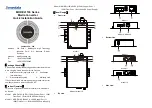
Assembly instructions - Collector
5
Instructions for installation and transport
The installation may only be carried out by qualified personnel. Only the supplied material should be used for the
installation. Please inform yourself about the applicable local norms and regulations before mounting and operating
the solar system. Note: Installing a collector array signifies an intervention into an existing roof. Roof coverings,
e.g. tiles, shingle and slate, especially in the case of converted and inhabited loft spaces or roofs with less than the
minimum slope (with regards to the covering), require additional on-site measures, e.g. sarking, as security against
water penetration caused by wind pressure and driving snow. For large collector arrays it is often advantageous to
mount the collectors on a special supporting structure made of steel channels. This substructure and its connections
to the main building structure should be designed on-site in accordance with the local conditions. Alternatively, it is
possible to install the collectors without perforating the roof membrane by using concrete ballast with guys. The
collectors are mounted on concrete blocks. Rubber mats should be used if necessary to protect the roof membrane
against damage and to increase the friction between the roof and the ballast blocks. In addition, it is necessary to
secure the collectors with 5mm steel cables (minimum tensile strength 1450N/mm˛) to absorb any peak wind loads.
The permissible roof loading and the fixing points on the building for the steel cables should be verified on-site by
a structural engineer.
The use of a carrying strap is recommended for transporting the collector. The collector must not be lifted at the
connections or on the threading. Avoid impacts and mechanical action on the collector, especially on the solar glass
and the pipe connections.
Structure
The collectors may only be mounted on sufficiently load-bearing roof surfaces and substructures. The structural
load-bearing capacity of the roof and the substructure must be tested on-site before mounting the collectors. Here,
particular attention should be paid to the quality of the timber substructure in terms of the stability of the screw
joints necessary for installing the collectors. In particular, it is essential to have the entire collector structure verified
at the installation site according to DIN 1055, Part 4 & 5 or according to country-specific regulations in regions with
heavy snowfalls (Note: 1mł powder snow ~ 60kg/1mł wet snow ~ 200kg) or in regions with high wind speeds. The
assessment should also take into account any special features of the particular site that could lead to increased loads
(foehn wind, air jets or eddy formations, etc). Collector arrays should always be installed in such a way that any
possible snow piles caused by snow trap grids (or the position of the collectors) do not reach the collectors. Here
must be at least 1m distance from roof ridging or edges.
Lightning protection / Equipotential bonding of the building
It is not necessary to connect collector arrays to the lightning protection of the building (please observe the country-
specific regulations). For installations on metal substructures at the installation site, authorized lightning protection
specialists must be consulted. The metal tubes of the solar circuit must be connected to the main potential
equalization bus by means of a conductor (green/yellow) with a cross-section of at least 16mm˛ CU (H07 V-U or R).
It is possible to ground the collectors to a ground rod. The grounding line must be laid outside the house. The ground
rod must also be connected to the main potential equalization bus by a line with the same cross-section as above.
Connections
(screw connections)
Depending on the design, the collectors must be connected with one another and/or the connection pipes using
screw fittings (ľ" internal/external thread ) with flat-face sealing. Ensure correct placement of the flat gaskets. If
flexible pipes are not used as connectors, precautions must be taken to protect the connection pipes against
temperature fluctuations caused by heat expansion (expansion bends/flexible piping). In this case, no more than 6
collectors may be connected in series. Larger collector arrays must be assembled with expansion bends or flexible
members inserted in the links (IMPORTANT: check the pu mp design). When tightening the connections, always
apply counter-pressure with a wrench or another spanner to prevent damage to the absorber.
Collector inclination / General notes
The collector is suitable for angles between 15° (minimum) and 75° (maximum).
Steps must be taken to ensure that water and other contaminants such as dust, etc. are prevented from getting into
the collector connections and ventilation holes.
Connecting support rails
If several support rails are to be mounted in series, they must be connected with the connectors above and below.
Warranty
Warranty claims can only be made if the supplier's own antifreeze is used and maintenance is carried out correctly.

































